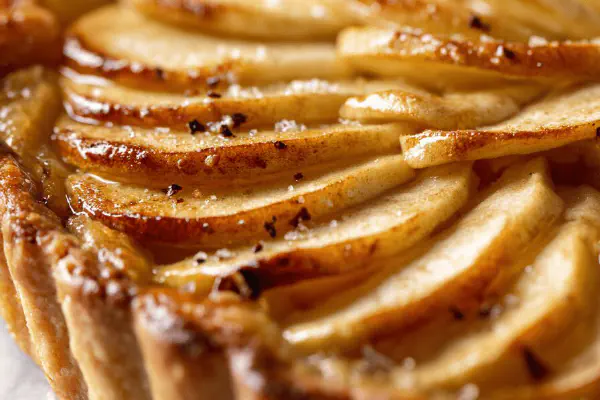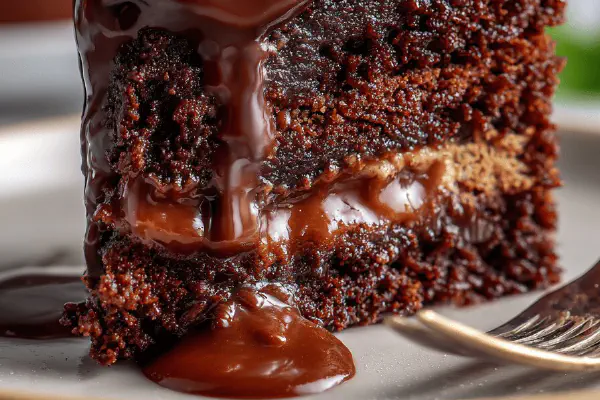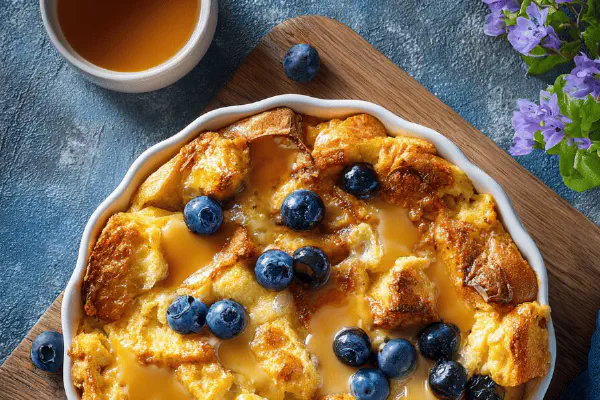Apple Tart Reimagined

By Emma
Certified Culinary Professional
Ingredients
Filling
- 45 ml butter unsalted
- 200 ml brown sugar packed
- 2 litres Fuji apples peeled and cored, each sliced into 8 wedges (7-9 medium)
- 400 ml Granny Smith apples peeled and cored, each sliced into 8 wedges (2 medium)
- 2 ml ground nutmeg
Crust
- 420 ml all-purpose flour not bleached
- 1 ml fine salt
- 200 ml cold unsalted butter diced
- 60 ml ice water
- 5 ml apple cider vinegar
- 30 ml cornstarch
About the ingredients
Method
Crust
- 1. In processor pulse flour with cornstarch, salt, and butter until mixture resembles peas. The cornstarch here helps absorb moisture from apples and keeps crust crisp. Slowly stream ice water mixed with vinegar and pulse until dough just starts forming into clumps. Avoid over-processing to keep crumbly texture.
- 2. Dump dough onto floured surface, quickly pat into two discs. Wrap tight in plastic wrap to prevent drying. Chill at least 40 minutes; longer if possible — firms butter, aids rolling.
Filling
- 3. Melt butter in heavy skillet. When foaming gently, add brown sugar and stir for 1 minute until it bubbles and smell deepens. Too much cooking, sugar burns, so stay alert. Toss in apples and sprinkle nutmeg. High heat; toss often. Watch for Granny Smiths to soften and Fuji to get tender but hold shape. Syrup should thicken, almost clinging, not watery. Remove from heat. Cool to room temp to avoid soggy bottom.
Assembly & Baking
- 4. Oven rack one notch below center. Preheat oven to 215°C (420°F). Flour counter, roll out one disc edge-to-edge into 23 cm (9 inch) circle but no thinner than 3 mm. Transfer to tart pan, gently press dough to edges and bottom. No tugging; patch tears immediately. Spreading the filling in a modest mound prevents juice pooling.
- 5. Roll out second dough disc into similar circle. Using a small cutter or round tip (around 1.5 cm diameter), punch five holes spaced evenly. These vents release steam and avoid cracking edges.
- 6. Place second crust over apples. Pinch edges firmly with bottom crust. Fork tines pressed lightly all around seal completely. Don’t skip this—steam escapes here or all goes disaster. Brush top crust with heavy cream. Gives golden brown sheen and a bit of richness. Skip milk; cream browns better and helps texture.
- 7. Bake about 38-40 minutes; watch crust color closely after 30 minutes. Some ovens run hot; foil crust edges mid-bake if it browns too fast. Crispness should sound firm when tapped lightly. Be patient before slicing—letting cool 15 min lets filling set up, less watery mess.
- 8. Store loosely covered at room temp max 3 days. Refrigeration prolongs but changes texture. Warm slightly before serving; filling aromas reawaken.
Cooking tips
Chef's notes
- 💡 Dough texture critical. Pulse flour, cornstarch, salt, butter until pea-size lumps. Avoid over-processing or crust turns dense. Stream ice water plus vinegar slowly. Dough clumps but stays crumbly. Chill at least 40 minutes; butter firms and dough relaxes gluten. Too little chill, shrinking or tears appear. Handle dough gently; excess kneading toughens crust. Floured surface helps but excess flour dries dough; balance is subtle here. Keep cold dough cold throughout.
- 💡 Caramel stage needs attention. Melt butter low heat first, bubbles form, gentle foaming. Add brown sugar and stir constantly. Sugar darkens but don’t burn; smell deepens, syrup thickens slightly. Too much heat or time burns sugar bitter. Apples tossed in while hot; toss often high heat. Fuji apples soften, hold shape; Granny Smiths tart, soften slower. Syrup should cling, not runny watery juice. Remove from heat at thick, glossy stage; cool before filling crust to prevent sogginess.
- 💡 Rolling dough thick enough prevents tearing. Aim no thinner than 3 mm. Thin crusts crack, leak filling juice. Patch tears quickly, no stretching dough. Roll discs evenly. Vent holes on top crust let steam escape. Five holes spaced evenly enough to prevent blisters or soggy top patches, but not too many or juice escapes. Pinch edges tight with fork tines all around; sloppy seals equal leaks and burnt edges. Tight but not neat works best.
- 💡 Cream wash for top crust browns richer than milk. Brush just before baking, not earlier or crust seals too soon, stops rising. Oven at 215°C (420°F) recommended but watch crust closely after 30 minutes. Ovens vary; foil edges mid-bake if browns too fast to avoid burnt crust. Crispness sounds firm when tapped gently. Tap and eye color key indicators; dull means needs more, golden means ready. Baking times adjusted slightly (about 5%) from standard due to ingredient swaps. Sensory cues beat clocks.
- 💡 Cooling crucial. Hot slicing ruins structure; cuts runny filling, messy layers. Let rest 15 minutes minimum, filling firms and sets. Store loosely covered at room temp up to 3 days. Refrigerate extends life but changes texture; crust loses crispness, filling tightens oddly. Warm gently before serving to revive aromas. Avoid airtight containers; moisture traps soften crust. Storing with slight venting keeps balance.
Common questions
Why add cornstarch in crust?
Absorbs apple moisture. Keeps crust from soggy bottom. Also makes dough flaky yet stable. Helps pastry hold together under juicy filling. Without it, juice seeps, crust turns mushy or collapses.
Substitutions for butter in crust?
Use vegan butter or firm margarine to avoid dairy. Lard or solid vegetable shortening works but texture changes. Butter coldness key. Some fats less flavorful, texture denser or crumblier. Measure carefully to keep dough consistency right.
What if filling too watery?
Cook apples longer on high heat. Sugar thickens syrup, watch carefully. Cool fully before filling crust. Cornstarch in dough helps but can add a pinch extra if needed. Avoid soft apples releasing excess juice. Proper sealing key to avoid leaks.
How best to store tart after baking?
Room temp loosely covered three days max. Refrigeration extends but affects crust texture. Use vented container or cover with foil tent. Warm slightly before serving to refresh flavors. Avoid airtight seals trapping moisture and sogginess.



